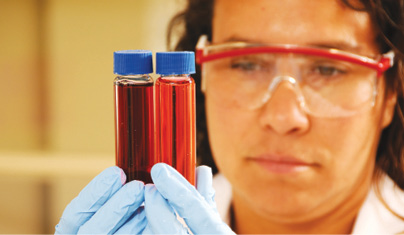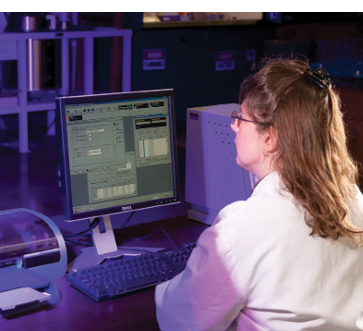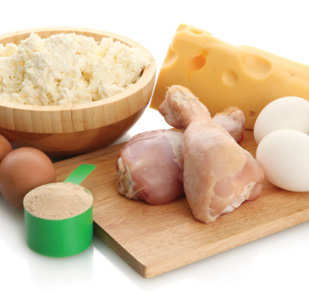
The changing face of microbiology
 Humanity has relied on microbial fermentation for thousands of years for the production of wine, beer, yogurt and bread. Today, the significance of microbiology has not diminished with microbes still being used for the production of food and increasingly fuels and chemicals. The reduction in cost for genetic tools and high throughput screening equipment has made microbial products more readily available to an increasing number of markets (enzymes in feed markets). You can expect in the next 25 years this trend will only continue as we increasingly turn to microbial systems for sustainable solutions to some of the nation’s most challenging problems.
Humanity has relied on microbial fermentation for thousands of years for the production of wine, beer, yogurt and bread. Today, the significance of microbiology has not diminished with microbes still being used for the production of food and increasingly fuels and chemicals. The reduction in cost for genetic tools and high throughput screening equipment has made microbial products more readily available to an increasing number of markets (enzymes in feed markets). You can expect in the next 25 years this trend will only continue as we increasingly turn to microbial systems for sustainable solutions to some of the nation’s most challenging problems.
Jimmy Gosse, Microbiologist
Coproducts industry
 For years, coproducts have been utilized by agriculture and industry. Centuries ago, farmers used straw, a coproduct from grain, for livestock bedding. In the last 25 years, we have greatly increased the focus on adding greater value to coproducts. One example is dried distillers grains with solubles (DDGS), a coproduct of ethanol, which is great for livestock feed because it is high in energy and high in protein. Today, ethanol plants are looking to add even greater value to DDGS by removing additional corn oil for other uses such as an energy source for poultry diets or for biodiesel production. Glycerin, a byproduct of biodiesel, is also being used for its value as feed source or in human health care products. These are just a few of very many ways that coproducts are adding value and decreasing waste for manufacturers and farmers.
For years, coproducts have been utilized by agriculture and industry. Centuries ago, farmers used straw, a coproduct from grain, for livestock bedding. In the last 25 years, we have greatly increased the focus on adding greater value to coproducts. One example is dried distillers grains with solubles (DDGS), a coproduct of ethanol, which is great for livestock feed because it is high in energy and high in protein. Today, ethanol plants are looking to add even greater value to DDGS by removing additional corn oil for other uses such as an energy source for poultry diets or for biodiesel production. Glycerin, a byproduct of biodiesel, is also being used for its value as feed source or in human health care products. These are just a few of very many ways that coproducts are adding value and decreasing waste for manufacturers and farmers.
Alan Doering, Senior Associate Scientist – Coproducts
Real-time analytical data
 In order to maintain quality control in manufacturing, businesses used to pull samples from the production line, take them to labs and do the necessary analysis there. Today, there are instruments with probes that can be placed right in the manufacturing stream. Add to that the software, calibration information and standard libraries now available, and manufacturers can take continuous analytical measurements. This real-time analytical data allows them to correct problems faster, saving time and money, and creating better products.
In order to maintain quality control in manufacturing, businesses used to pull samples from the production line, take them to labs and do the necessary analysis there. Today, there are instruments with probes that can be placed right in the manufacturing stream. Add to that the software, calibration information and standard libraries now available, and manufacturers can take continuous analytical measurements. This real-time analytical data allows them to correct problems faster, saving time and money, and creating better products.
Ranae Jorgenson, Analytical Chemist

 In 1993, there was a critical event in the history of food safety. The E.coli O157:H7 outbreak in the Pacific Northwest associated with the Jack in the Box restaurant chain brought about some major changes to how food safety is handled in this country. That outbreak served as a catalyst for increased attention to food safety from a farm-to-fork perspective. E.coli O157:H7 was deemed an adulterant following the 1993 outbreak. Meat processors who produce beef trimmings or ground beef products have to test for its presence. In addition, in 1996 legislation was passed requiring meat and poultry processors to have a Hazard Analysis and Critical Control Points (HACCP) plan in place. AURI has teamed together with the University of Minnesota to offer HACCP courses on a regular basis. In addition, AURI’s meat scientist regularly consults with processors on food safety programs and planning.
In 1993, there was a critical event in the history of food safety. The E.coli O157:H7 outbreak in the Pacific Northwest associated with the Jack in the Box restaurant chain brought about some major changes to how food safety is handled in this country. That outbreak served as a catalyst for increased attention to food safety from a farm-to-fork perspective. E.coli O157:H7 was deemed an adulterant following the 1993 outbreak. Meat processors who produce beef trimmings or ground beef products have to test for its presence. In addition, in 1996 legislation was passed requiring meat and poultry processors to have a Hazard Analysis and Critical Control Points (HACCP) plan in place. AURI has teamed together with the University of Minnesota to offer HACCP courses on a regular basis. In addition, AURI’s meat scientist regularly consults with processors on food safety programs and planning.
Carissa Nath, Meats Scientist
Renewable energy and biobased products
 In renewable energy, the biggest developments have been ethanol and biodiesel as a significant replacement to petroleum-based transportation fuels. We now have biobased transportation fuels that are cost competitive to manufacture, can be blended into the existing transportation fuels supply and have good environmental benefits. Minnesota and AURI have occupied leadership positions with these fuels. Continued development of transportation fuels and biobased chemicals like butanol and dimethylether (DME) are on the horizon as a result of the success of ethanol and biodiesel. In the biobased products area, the development of polylactic acid, which is made from corn and can be turned into plastic, has cracked the door for a renewable, biobased replacement to the traditionally petroleum-based plastics. It’s taken more than 15 years to get polylactic acid from basic research out into the market, and it could have a big place in our future.
In renewable energy, the biggest developments have been ethanol and biodiesel as a significant replacement to petroleum-based transportation fuels. We now have biobased transportation fuels that are cost competitive to manufacture, can be blended into the existing transportation fuels supply and have good environmental benefits. Minnesota and AURI have occupied leadership positions with these fuels. Continued development of transportation fuels and biobased chemicals like butanol and dimethylether (DME) are on the horizon as a result of the success of ethanol and biodiesel. In the biobased products area, the development of polylactic acid, which is made from corn and can be turned into plastic, has cracked the door for a renewable, biobased replacement to the traditionally petroleum-based plastics. It’s taken more than 15 years to get polylactic acid from basic research out into the market, and it could have a big place in our future.
Doug Root, Senior Scientist of Biomass & Renewable Products Technologies
The Power of Protein in Food
 Beyond traditional sources of protein, such as meat, fish and poultry, consumers are seeking new protein options, and dairy and plant-based proteins are moving front and center in product development. The Institute of Food Technologists (IFT) recently named protein as one of 2014’s functional food trends that will likely shape new products in the food and beverage industry in the coming year. According to Mintel, dairy leads with the most protein claims in food products, but the snack industry also shows growth with breakfast, beverages and bakery trending. Protein claims now appear in virtually every product category, indicating its demand and wide consumer appeal. Dairy products contribute nearly 20% of the protein in the U.S. diet and are nutrient-rich foods with an appealing “good for you” health halo. Nearly 80% of U.S. consumers want more protein in their foods and look to a wide range of sources to meet this need. The global protein market is projected to reach $24.5 billion by 2015 and about half of that market is estimated to be dairy proteins, but a strong focus is on plant-based proteins. Rising costs, clean labels and sustainability concerns are the reasons behind the nondairy, meat-free moderate shift. The power of protein and its health benefits now impacts a broad range of food product types and consumer demographics.
Beyond traditional sources of protein, such as meat, fish and poultry, consumers are seeking new protein options, and dairy and plant-based proteins are moving front and center in product development. The Institute of Food Technologists (IFT) recently named protein as one of 2014’s functional food trends that will likely shape new products in the food and beverage industry in the coming year. According to Mintel, dairy leads with the most protein claims in food products, but the snack industry also shows growth with breakfast, beverages and bakery trending. Protein claims now appear in virtually every product category, indicating its demand and wide consumer appeal. Dairy products contribute nearly 20% of the protein in the U.S. diet and are nutrient-rich foods with an appealing “good for you” health halo. Nearly 80% of U.S. consumers want more protein in their foods and look to a wide range of sources to meet this need. The global protein market is projected to reach $24.5 billion by 2015 and about half of that market is estimated to be dairy proteins, but a strong focus is on plant-based proteins. Rising costs, clean labels and sustainability concerns are the reasons behind the nondairy, meat-free moderate shift. The power of protein and its health benefits now impacts a broad range of food product types and consumer demographics.
Donna O’Connor, Scientist of Food & Nutrition
Health and nutrition
 The biggest change I’ve seen in the last 25 years in the area of food technology has been the positive shift towards health and nutrition. As a result, AURI has had many projects in this area including the development of functional foods, which are known for their health benefits beyond basic nutrition. Functional ingredients, including protein, omega 3, Beta-glucan and many others, each have specific benefits such as disease prevention or health promotion. AURI has helped with the development of functional foods, such as helping French Meadow Bakery formulate their Men’s Bread® with ginseng and soy protein and Woman’s Bread® with soy isoflavones and cranberries. In addition to functional foods, we’ve seen increased development in low-fat, low-carb, reduced- salt-and-sugar, sugar-free, organic,
The biggest change I’ve seen in the last 25 years in the area of food technology has been the positive shift towards health and nutrition. As a result, AURI has had many projects in this area including the development of functional foods, which are known for their health benefits beyond basic nutrition. Functional ingredients, including protein, omega 3, Beta-glucan and many others, each have specific benefits such as disease prevention or health promotion. AURI has helped with the development of functional foods, such as helping French Meadow Bakery formulate their Men’s Bread® with ginseng and soy protein and Woman’s Bread® with soy isoflavones and cranberries. In addition to functional foods, we’ve seen increased development in low-fat, low-carb, reduced- salt-and-sugar, sugar-free, organic,
all-natural and allergen-free products.
Charan Wadhawan, Senior Scientist of Food & Nutrition
Podcast: Play in new window | Download (1.4MB) | Embed
